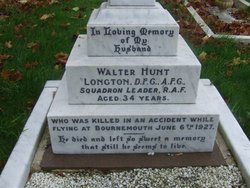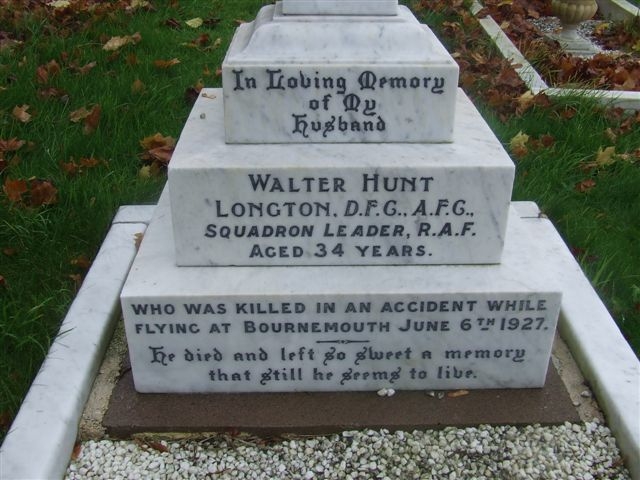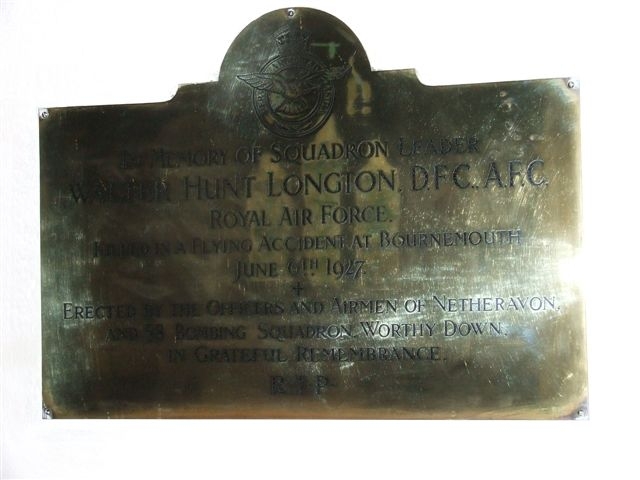He held the Distinguished Flying Cross and two bars, and the Air Force Cross.He was killed in a flying accident at Bournemouth, aged 34.
On 29 April 1916, Private Longton was commissioned a temporary second lieutenant in the Royal Flying Corps. On 12 July 1916, he was appointed a Flying Officer in the RFC; such appointments customarily were made at the end of pilot's training.
By mid-1918, he was posted to 85 Squadron as a Royal Aircraft Factory SE.5a pilot. On 3 June 1918, he was awarded the Air Force Cross by King George V upon the royal birthday. He would not score his first aerial victory until 7 July 1918, when he destroyed a German Fokker D.VII fighter plane over Doulieu. He destroyed three more enemy planes in July—a Hannover two-seater reconnaissance craft on the 10th, an Albatros two-seater on the 14th, and a Pfalz D.III on the 24th
On 5 August, he became an ace, setting another Albatros reconnaisance plane aflame. His next success, on 22 August 1918, not only gained him another victory, but was cited as a major reason for his receiving the Distinguished Flying Cross; citation:
On the 22nd August this officer led his formation of six machines to attack an equal number of enemy scouts. All the latter were accounted for, four being crashed and the remaining two driven down out of control. A brilliant performance, reflecting the greatest credit on this officer as leader, and all who took part in this engagement. During the last seven weeks Lieutenant Longton has destroyed seven enemy machines.
Longton would next score on 8 October, when he destroyed an opposing observation balloon south of Busigny. His dearth of victories in September is at least partially explained by the text of his award for a second Distinguished Flying Cross (which was awarded to him as a Bar)citation:
Between 29th September and 9th October this officer carried out twelve tactical reconnaissances, bringing back most valuable information; he also displayed great gallantry in attacking enemy troops on the ground. On 9th October, when on a low patrol, he observed a machine-gun nest which appeared to be the sole obstacle to our cavalry advance. Having informed the cavalry and field artillery of the situation, he co-operated with the former in their attack, and, after the enemy had been driven out, pursued them with machine-gun fire as they retreated.
Longton would finish October with a rush of victories. On the 14th, he destroyed a Fokker D.VII over Wassigny. On the 29th, he destroyed another Fokker D.VII at 1430 hours; half an hour later, he teamed with Thomas M. Harries and H. V. Evans to destroy an enemy reconnaissance two-seater, scoring a win for each flier. The following day, Longton closed out his victory roll with the destruction of a Fokker D.VII over Marville.
On 16 April 1919, Longton was demobilized when he ceased to be employed by the Royal Air Force, and gave up his commission. On 3 June 1919, Longton was awarded a second bar to his Distinguished Flying Cross "for services rendered during the war." He then re-enlisted and was granted a permanent commission as a lieutenant on 1 August 1919. On 1 November 1919, he was promoted to Flight Lieutenant.
He stayed in the Royal Air Force, and was a participant in the RAF Pageant at Hendon on 3 July 1920. A photo in Flight Magazine shows him seated in a Sopwith Camel adorned with Charlie Chaplin's Little Tramp on the side of its cockpit. At one point, he flew aerobatics, to much acclaim. He also competed in an air race but did not finish. He continued to participate in air exhibitions, races, and trials of various sorts through the 1920s right up until the year of his death. Accounts of his feats are scattered throughout the aviation press. His racing and trials work seem not to have hurt his professional prospects. On 1 January 1924, he was promoted from Flight Lieutenant to Squadron Leader.He is memorialized by a plaque erected by his old aviation comrades in 58 Squadron and Netheravon
(Sourced largely from Wikipedia)
He held the Distinguished Flying Cross and two bars, and the Air Force Cross.He was killed in a flying accident at Bournemouth, aged 34.
On 29 April 1916, Private Longton was commissioned a temporary second lieutenant in the Royal Flying Corps. On 12 July 1916, he was appointed a Flying Officer in the RFC; such appointments customarily were made at the end of pilot's training.
By mid-1918, he was posted to 85 Squadron as a Royal Aircraft Factory SE.5a pilot. On 3 June 1918, he was awarded the Air Force Cross by King George V upon the royal birthday. He would not score his first aerial victory until 7 July 1918, when he destroyed a German Fokker D.VII fighter plane over Doulieu. He destroyed three more enemy planes in July—a Hannover two-seater reconnaissance craft on the 10th, an Albatros two-seater on the 14th, and a Pfalz D.III on the 24th
On 5 August, he became an ace, setting another Albatros reconnaisance plane aflame. His next success, on 22 August 1918, not only gained him another victory, but was cited as a major reason for his receiving the Distinguished Flying Cross; citation:
On the 22nd August this officer led his formation of six machines to attack an equal number of enemy scouts. All the latter were accounted for, four being crashed and the remaining two driven down out of control. A brilliant performance, reflecting the greatest credit on this officer as leader, and all who took part in this engagement. During the last seven weeks Lieutenant Longton has destroyed seven enemy machines.
Longton would next score on 8 October, when he destroyed an opposing observation balloon south of Busigny. His dearth of victories in September is at least partially explained by the text of his award for a second Distinguished Flying Cross (which was awarded to him as a Bar)citation:
Between 29th September and 9th October this officer carried out twelve tactical reconnaissances, bringing back most valuable information; he also displayed great gallantry in attacking enemy troops on the ground. On 9th October, when on a low patrol, he observed a machine-gun nest which appeared to be the sole obstacle to our cavalry advance. Having informed the cavalry and field artillery of the situation, he co-operated with the former in their attack, and, after the enemy had been driven out, pursued them with machine-gun fire as they retreated.
Longton would finish October with a rush of victories. On the 14th, he destroyed a Fokker D.VII over Wassigny. On the 29th, he destroyed another Fokker D.VII at 1430 hours; half an hour later, he teamed with Thomas M. Harries and H. V. Evans to destroy an enemy reconnaissance two-seater, scoring a win for each flier. The following day, Longton closed out his victory roll with the destruction of a Fokker D.VII over Marville.
On 16 April 1919, Longton was demobilized when he ceased to be employed by the Royal Air Force, and gave up his commission. On 3 June 1919, Longton was awarded a second bar to his Distinguished Flying Cross "for services rendered during the war." He then re-enlisted and was granted a permanent commission as a lieutenant on 1 August 1919. On 1 November 1919, he was promoted to Flight Lieutenant.
He stayed in the Royal Air Force, and was a participant in the RAF Pageant at Hendon on 3 July 1920. A photo in Flight Magazine shows him seated in a Sopwith Camel adorned with Charlie Chaplin's Little Tramp on the side of its cockpit. At one point, he flew aerobatics, to much acclaim. He also competed in an air race but did not finish. He continued to participate in air exhibitions, races, and trials of various sorts through the 1920s right up until the year of his death. Accounts of his feats are scattered throughout the aviation press. His racing and trials work seem not to have hurt his professional prospects. On 1 January 1924, he was promoted from Flight Lieutenant to Squadron Leader.He is memorialized by a plaque erected by his old aviation comrades in 58 Squadron and Netheravon
(Sourced largely from Wikipedia)
Sponsored by Ancestry
Advertisement
Records on Ancestry
-
1911 England Census
-
Westminster, London, England, Church of England Marriages and Banns, 1754-1935
-
England & Wales, National Probate Calendar (Index of Wills and Administrations), 1858-1995
-
Lancashire, England, Church of England Births and Baptisms, 1813-1911
-
England & Wales, Civil Registration Death Index, 1916-2007
Sponsored by Ancestry
Advertisement









